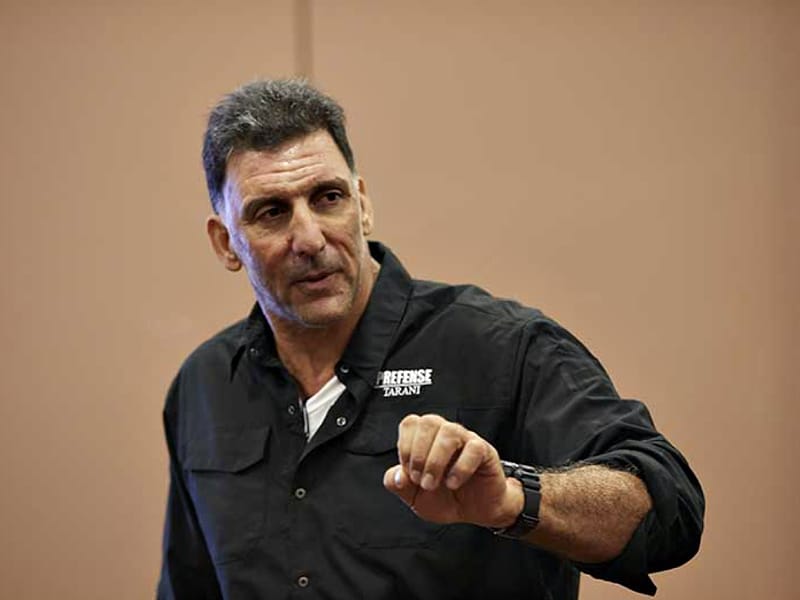In the world of active threat management there exist two viable measures that can be effectively applied. They are proactive measures and reactive measures.
Proactive measures are those that afford you control over a situation by doing something in anticipation of future problems. Reactive measures are those where you are acting in response to a situation rather than creating or controlling it.
Either you control the threat, or the threat controls you. When you are proactive, you initiate control prior to the unfolding of an undesired event. Being reactive means that you’ve been pushed back on your heels in response to someone else who has the initiative.

You are either ahead or behind the action-reaction power curve. Taking proactive measures places you ahead of the action-reaction power curve. Conversely, you are forced into reactive measures when you find yourself behind the action-reaction power curve and as a result, have no other choice but to respond to the event.
Nobody can predict the future, but you can choose to be prepared or remain unprepared to engage a real-world active threat. You may not know when it will happen or where it will happen, but you can make the choice that if it does happen, you will be either prepared or unprepared. Choosing to be prepared is choosing to not be unprepared.
Any consummate security professional will tell you that there are three common areas of operation (everyday scenarios) where you may want to be prepared with both proactive and reactive measures. One of these is at home, another is on foot, and another is when attending a public venue.
Home Prep
Applying proactive measures at home means that you have run a vulnerability assessment on your home, have identified actual or potential
security weaknesses and are taking such measures as to do something about it (or them) in anticipation of solving future problems.

Take a good hard look at the property around your home. Visually scan your front, back, and side yards. What can you do to deter interest from home invaders seeking a soft residential target? How can you make your home so unattractive to the criminal or opportunist intent on invasion and bad intent (to the extent of causing severe bodily harm or worse), that they move along to find softer targets?
One option is to remove any ladders, step stools, hammers, shovels, crowbars, and the like that may be readily available to facilitate a break-in. Installing a lock on the front gate, a thorny rose bush, or shrubs by a first-floor window, or motion lights if there aren’t any already installed, are also viable options.
The next proactive measure at home is the capability to detect any external activity utilizing cameras or motion sensor alarms. In addition to these, it’s a good idea to check the fastening devices on your windows, doors, and other ingress points to ensure quality locks and seals that cannot be easily defeated.
Failing deterrence, detection, and delay, you may then want to contemplate certain reactive measures such as an emergency action plan to include calling first responders, engaging the threat yourself, applying medical aid, and how to manage children, the elderly or infirm, and also pets in exigent circumstances.
Prepared on Foot
When walking from your vehicle to a convenience store or running errands on foot, especially during the holidays, there are recommended proactive measures. One of these and the most prevalent of all proactive measures is to apply situational awareness to your immediate environment.
You can’t control something you can’t see. Employing good situational awareness engages your mind with your surroundings which allows for data input to be quickly processed, affording you the benefit of making critical decisions ahead of time. This places you ahead of the action-reaction power curve.
Keeping your earbuds in and your eyes riveted to your phone makes you an attractive target to the predator looking for an easy mark and distracts you from engaging your mind with your environment. Predators go after lower-hanging fruit and there’s no lower-hanging fruit than someone who is unaware of a potential threat by being completely oblivious to their surroundings.

Failing the application of situational awareness, you may find yourself in a nasty situation backed up against a wall with more than one assailant
perhaps involving weapons at which time you have no remaining choices other than to rely on reactive measures such as hand-to-hand skills or a firearm.
Anytime things get physical, and you engage your body in a violent physical altercation it introduces the probability of sustaining injury. Injury is a tactical consideration and as such, it is recommended to sustain the least amount of injury possible when contemplating a physical response reactive measure.
Public Venue
Being in a crowded area such as a music concert, outdoor marketplace, or any situation where there may be a crowd of people gathered for an event or large-scale open public activity, warrants your being proactive by having a plan.
Your plan should include wearing appropriate attire conducive to making a run for it. Moving targets are always more difficult to hit than stationary targets. The “A” answer in an active shooting outdoors is to stay mobile and create distance, making yourself a more difficult target.
If bullets start flying, you need to mobilize immediately away from the shooter. To do this you cannot be wearing restrictive clothing or any type of insecure or non-conducive footwear such as flip-flops or unwieldy high heels. You must also establish a designated safe area to run toward. Is it your car? Is it the nearest building? Is it the nearest piece of cover? Is it somewhere you may be able to conceal yourself from the shooter’s field of vision or field of fire?

Another useful proactive measure is to get yourself medically trained. You don’t need to be a doctor or an emergency medical technician, but you should at least know the basics such as how to apply a tourniquet and how to stop the bleeding.
If others are with you at a public venue, it is recommended that you have a plan to move them just as quickly with you, and per your emergency action plan. They should be made aware of the plan if something happens. A simple talk-through review or pre-event briefing should suffice. Better to have and not need than need and not have.
Be Prepared
Regardless of if you may be at home, on foot, or at a public venue, preparation is the key to success in managing a real-world active threat.
Proactive measures are paramount to being prepared. Proactive measures allow you to take the initiative, stay well ahead of the action-reaction power curve, and place yourself and those with you in a position of advantage.
Foregoing any proactive or preventive measures relegates you to the only remaining threat management option—reactive measures. Failing to be proactive means that you can now only solve the problem physically at the cost of incurring possible physical injury or even death.
Although it may be beneficial (and recommended) to have a reliable toolkit of reactive measures, remember that these are still reactive. At the point that you must rely on them, you do not have (or have lost) the initiative, are behind the curve, and could get hurt or even be killed in the process.
Conversely, proactive measures give you the initiative, make you a far more undesirable target, and place you ahead of the curve. Proactive measures are preventive measures and are the recommended “A” answer to successful active threat management.


